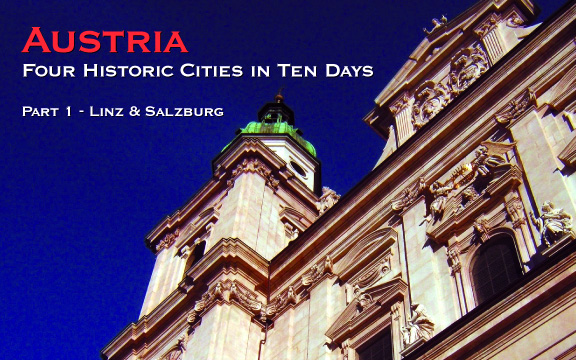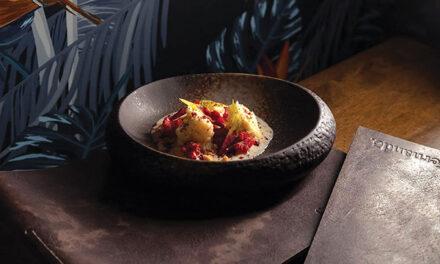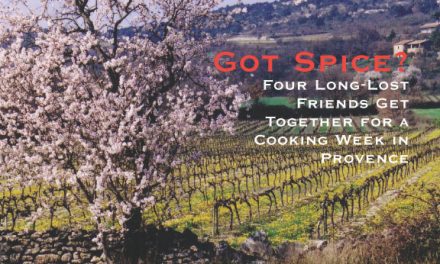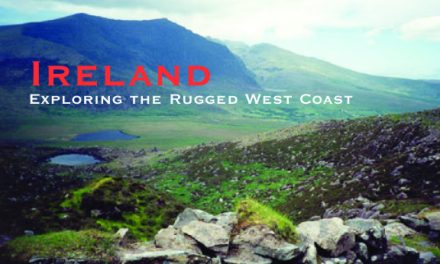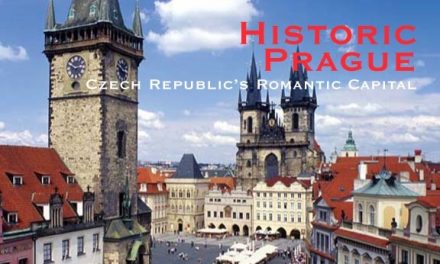Austria: Four Historic Cities in Ten Days
Part 1 – Linz & Salzburg
Published in the Winter 2006-07 Issue of Canadian World Traveller
By Natalie Ayotte and Michael Morcos
Cover Photo: Austrian Tourist Office
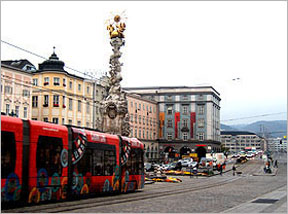 Our exciting four-city tour of Austria began at Toronto’s Pearson International Airport where we boarded anAustrian Airlines jet for our direct flight to Vienna.
Our exciting four-city tour of Austria began at Toronto’s Pearson International Airport where we boarded anAustrian Airlines jet for our direct flight to Vienna.
As it was quite late in the fall season, we knew that we would be spending our highly- anticipated ten-day sojourn in Austria after the throngs of summer tourists had departed and before the arrival of the countless number of winter vacationers who visit Austria’s famous ski resorts each year.
In this article, we visit Linz and Salzburg, the first and second stops of our countrywide tour.
Touring Austria by Train
On arrival at Vienna’s International Airport, we made our way directly to the “Wien Westbahnhof” to catch a westbound intercity train to the historic city of Linz.
Our stay in Vienna would have to wait until the end of our circular tour, which included the Austrian capital, as well as the regional cities of Linz in Upper Austria, Salzburg in Salzburger Land, and Graz in the Styria Region of the country.
We were fortunate to have first-class Rail Europe Passes, which allowed us to get from city to city with great ease and comfort.
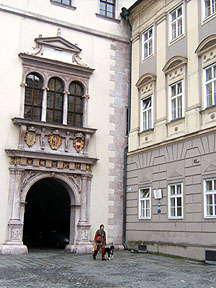 Linz: Capital of Upper Austria
Linz: Capital of Upper Austria
The train to Linz was on time to the second. We soon discovered that all Austrian trains run on time. This also applies to Austrian airline flights, buses, trams, concerts, meetings and every other scheduled activity in the country. This national obsession dictates that time should never be wasted and should always be honoured… to the very minute!
In Linz, which dates back to before Roman times, we stayed at theArchotel Hotel Nike, located directly on one of the banks of the Danube River.
The city actually straddles a very scenic bend in this fabled river. Our recently renovated, tenth-floor room afforded us a fantastic view of the Danube, the city centre and the surrounding hills.
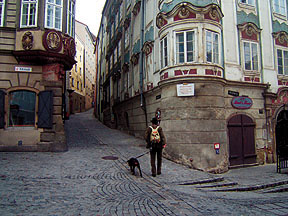
A Thrilling Experience
Shortly after checking in, we were met by our Austrian guide, who was on time (of course). He took us on a picturesque walk along the river bank to visit the Ars Electronica Centre, a unique state-of-the-art museum designed to show visitors how easy computers are to use and how interactive they can be.
Here, I had a chance to be strung up by wires and enjoy the virtual sensation of flying through the City of Linz, just by moving my arms. That was quite the experience!
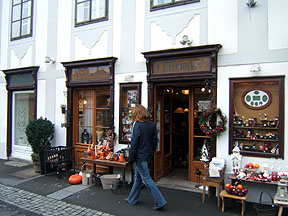 A European Capital of Culture
A European Capital of Culture
Later over supper, we learnt that Linz is preparing for its coveted role as a European Capital of Culture in 2009. That’s quite an honour for this city of only 200,000 inhabitants.
But despite its size, Linz sure offers a lot for the visitor to see and do. During the following day and a half, we would come to realise that we couldn’t possibly do it all.
Our supper was at a restaurant housed in a historic 13th-century building located on the main square. We enjoyed a typically hearty Austrian meal that included dumpling soup and Wiener Snitzel. As to be expected, the local beer was great! Our chef, who was also the owner, gave us a tour of the wine cellar, located in the basement, as well as the upper floors, which offered something special.
A Private Chapel
One of the previous owners had commissioned a private chapel to be built above the restaurant. This included a marble altar, statues of various saints and frescos. The chapel was constructed during the 18th-century conversion of most Austrians from Protestantism back to Catholicism and was the owner’s way of showing that he had indeed become a devout Catholic. Today, some 80 percent of Austrians are Roman Catholic.
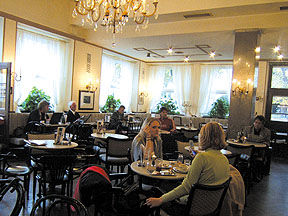 Danube Vista
Danube Vista
The next day, we once again enjoyed the stunning view of the Danube while having our continental breakfast at the hotel. We then left for a stroll through the small charming streets of the old town. I marvelled at how well organized everything was. Even the smallest detail did not escape the attention of the good people of Linz.
Getting in from the autumn morning chill for a bit, we slipped into one of those famous Austrian cafés. The Old World atmosphere, coffee and service were everything I imagined they would be.
Postlingberg Tram
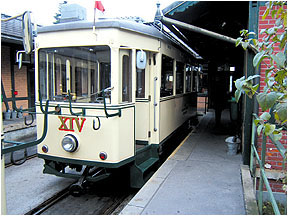 From the café, we headed for the town’s main square to catch the Postlingberg Tram, which is Europe’s steepest tramway. It took us to the top of Postlingberg Hill, which overlooks the city, the river and the entire region.
From the café, we headed for the town’s main square to catch the Postlingberg Tram, which is Europe’s steepest tramway. It took us to the top of Postlingberg Hill, which overlooks the city, the river and the entire region.
Built in 1898, the tram is an important means of transport for the owners of the impressive hillside homes.
The fortress that once stood at the very top of the hill was built to defend the local population from attacks by outsiders.
The view of the river valley as far as the eye could see, included the old and new parts of the city, as well as its industrial sectors, Linz being well-known for its steel and chemical industries.
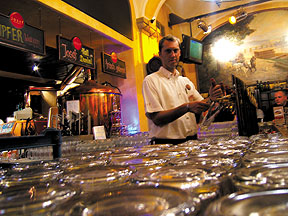
Josef’s Bar & Restaurant
We spent our last evening in Linz walking along its main street and window-shopping and ended up at Josef’s, one of the city’s most famous restaurants.
Once again we opted for the excellent local fare of sausages, pork, beer and wine and needless to say, the service was as prompt and courteous as ever.
Warhol in Linz
Our stay in Linz was all too short, but we did have enough time to visit the Lentos Museum of Modern Art. Its architecture is quite stunning, as the building looks like a bridge covered in multicoloured glass. The museum houses works by notable 19th and 20th-century artists, including some of those by Andy Warhol.
Unfortunately, we didn’t have time to visit the impressive Renaissance Landhaus Palace, which ironically was situated just next door to our hotel. I guess we’ll have to do so on a return visit in 2009 when Linz will be heralded as a European Capital of Culture.
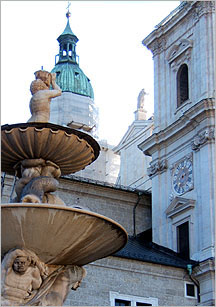
Salzburg: Mozart’s Birthplace
On our early morning ‘on-time’ train from Linz to Salzburg, we enjoyed spectacular views of the Austrian countryside. We had three great days ahead of us in the city made famous by its favourite son Wolfgang Amadeus Mozart.
Our first impression of the city was that it was so well preserved. Historic buildings lined its cobblestone streets. Age-old bridges spanned the Salzach River that separates the old and new parts of town and the mighty Hohensalzburg Fortress loomed majestically over the entire picturesque scene.
We decided to spend the afternoon soaking in the atmosphere and getting ourselves orientated by walking around the city.
That evening, we had supper at a great little restaurant not far from the Castellani Parkhotel where we were staying. As most of the tourists had left, the place was filled with locals chatting in their unique Austrian version of German while eating and drinking the night away.
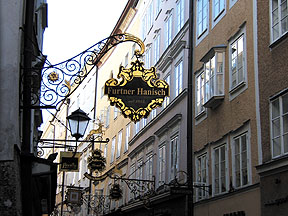
The Getreidegasse
The following day, we visited the birthplace and residence of Mozart located on Getreidegasse, the main pedestrian street of the old town.
The shops along both sides of this animated street all had traditional signs extending from their doorways, some of them centuries old. They seemed to form archways across the narrow street.
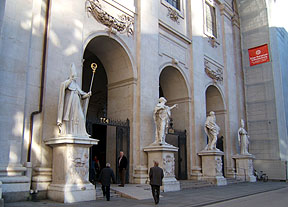
Later, we made our way to the city’s cathedral church of St. Rupert and St. Virgil. This 8th-century “Dom” is one of the outstanding landmark buildings of Salzburg. In front stood a statue some three stories high, towering over the square.
Other notable stops along our route were the 13th-century Franziskanerkirche Church; the Stift St. Peter Church built in the 12th-century; and the open-air Farmers Market, where we were impressed by the quality and presentation of the fresh vegetables, so shiny, they almost looked artificial.
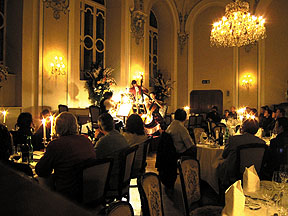 A Musical Feast
A Musical Feast
A special treat unfolded that evening when we attended a dinner concert in a traditional venue that has been used for such occasions since the days of Mozart.
While indulging in typical Austrian fare, we were entertained by a quintet of classical musicians who were later joined by two opera singers.
As we wended our way back to the hotel, I couldn’t help but feel that we owned the town, as there was not a single other soul in its deserted streets. What a great feeling and what a great evening!
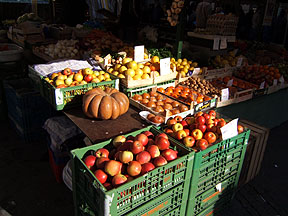
Schloss Mirabell
Our last day (already) in charming Salzburg was jam-packed with activities. We started the day at the Farmers Market in the square in front of Schloss Mirabell.
We were surprised to find it already crowded with Salzburgers who seemed to prefer buying their fresh produce on a daily basis.
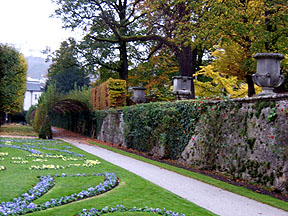 The Schloss Mirabell palace, built in 1727, stands on the site originally used in 1606 by Archbishop Wolf Dietrich to build a mansion for his beloved mistress who bore him 15 children! The present-day palace, which houses a Baroque Museum, is surrounded by attractive gardens. The gardens’ beautiful sculptures and fountains alone make it a must-see when visiting Salzburg.
The Schloss Mirabell palace, built in 1727, stands on the site originally used in 1606 by Archbishop Wolf Dietrich to build a mansion for his beloved mistress who bore him 15 children! The present-day palace, which houses a Baroque Museum, is surrounded by attractive gardens. The gardens’ beautiful sculptures and fountains alone make it a must-see when visiting Salzburg.
Before heading back to the old part of town, we climbed the 250 steps to the top of Kapuzinerberg Hill on the right bank of Salzach River and were rewarded with a wonderful panoramic view of the city and the river.

Mozartplatz
Our next stop was Mozartplatz, with its imposing statue of (you guessed it) Mozart. After all, this was the 250th anniversary of the birth of Salzburg’s preeminent composer and the “Viva! Mozart” exhibition in the recently restored Neue Residenz Palace located on the square, was a yearlong celebration of his genius. The exhibition was an excellent way to learn about the brilliant composer’s life and works.
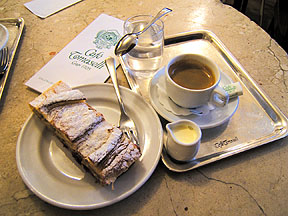
To replenish ourselves, we had a coffee at Café Tomaselli, a favourite haunt of Mozart’s. This world-famous café was established in 1705!
Hohensazburg Fortress
We then headed for the most famous Salzburg landmark of all, the Hohensalzburg Fortress. In no time, a cable car whisked us up to the peak of Festungsberg, the rocky hill that dominates Salzburg’s skyline.
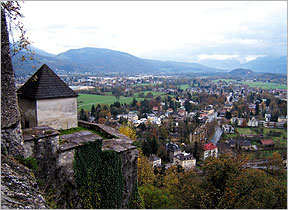 The view from the fortress, constructed on the crest of the hill in the 11th century, was indeed breathtaking. Over the centuries, the fortress was expanded to its present-day gigantic size. We took a guided tour, but we were only able to see a fraction of this incredible historical site.
The view from the fortress, constructed on the crest of the hill in the 11th century, was indeed breathtaking. Over the centuries, the fortress was expanded to its present-day gigantic size. We took a guided tour, but we were only able to see a fraction of this incredible historical site.
That evening, we attended our second concert in two nights. This time, there were no opera singers, but the fantastic venue, specifically designed for these functions, was actually a large room at the top of the fortress.
Once again, as we made our way back by foot to our hotel, we felt we owned the quiet, serene streets of Salzburg.
Salzburg Farewell
The following morning, we reluctantly said farewell to Salzburg and embarked on the third leg of our four-city tour. Our next stop would be Graz, the capital city of the southeastern Styria Region of Austria and the second largest city in the entire country.
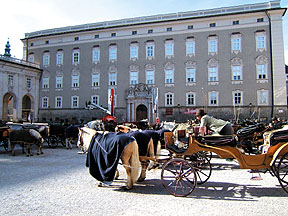 Our time we spent in both Linz and Salzburg was much too short, as was our entire 10-day tour of historic Austrian cities. I guess this is the sign of a really good trip! We vowed to return to Austria to see all that we missed and to indulge once again in the beautiful things that made our visit so memorable!
Our time we spent in both Linz and Salzburg was much too short, as was our entire 10-day tour of historic Austrian cities. I guess this is the sign of a really good trip! We vowed to return to Austria to see all that we missed and to indulge once again in the beautiful things that made our visit so memorable!
Be sure tobookmark this siteand join us for Part 2 of our article covering the cities of Graz and Vienna, which will be published in the Spring 2007 Issue of Canadian Word Traveller Magazine.
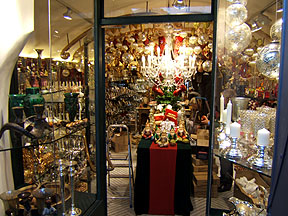
For More Info on Austria
Contact: The Austrian Tourist Office
Tel.: 416-967-3381
Email: travel@austria.info
Website: www.austria.info

